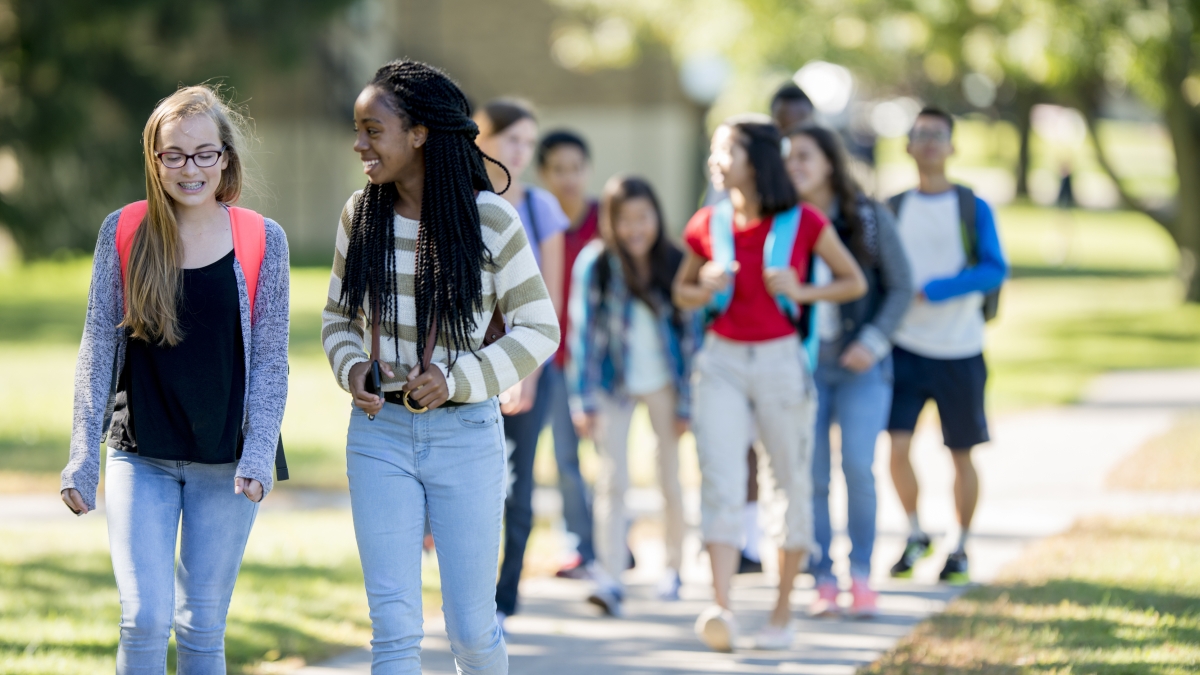Each year, nearly 20% of U.S. students do not finish high school on time, which experts say puts them at high risk for poverty, poor health and early mortality.
There is a key moment at the beginning of their high school career, however — the transition into ninth grade — that represents an important point in the journey toward high school completion and long-term success.
A groundbreaking new experimental study with more than 12,000 ninth grade students in the U.S. confirmed that a low-cost online program that takes less than an hour to complete can help students develop a growth mindset — the belief that intellectual abilities are not fixed but can be developed. This is important because student motivation often suffers when students have been exposed to the idea that their intellectual abilities can’t change.
Both lower- and higher-achieving students benefited academically from the program. On average, lower-achieving students who took the program earned significantly higher grades in ninth grade, and both higher- and lower-achieving students selected more challenging math courses in 10th grade.
Prior research had found that such interventions — which do not change the curriculum, but rather change how adolescents think about themselves in ways that encourage them to stay motivated when school is challenging — could improve academic outcomes in smaller samples, but it had not been previously clear whether these interventions could work on a national level.
A multidisciplinary team of researchers conducted the new research, called the National Study of Learning Mindsets (NSLM), the largest-ever randomized controlled trial of a growth mindset program in the U.S. in K-12 settings. The results are summarized in a new paper published Wednesday in the journal Nature.
“The National Study of Learning Mindsets is a major milestone for science,” said lead author David Yeager, associate professor of psychology at the University of Texas at Austin. “The research cemented a striking finding from multiple earlier studies: A short intervention can have an unlikely outcome — it can change adolescents’ grades many months later. The study also showed us something new. Students who already get high grades don’t get higher grades when they get the treatment, but they are more likely to take harder mathematics classes that can set them up for long-term success.”

Richard Hahn
The study team featured experts from the fields of education, psychology, sociology, economics and statistics — including Arizona State University Associate Professor Richard Hahn — and took place in a sample of schools selected randomly, ensuring that generalizations from the sample to the U.S. population of high schools could be better made.
In addition to the academic success of study participants, the research also revealed important insights about how school context can affect the impact of the growth mindset program.
Lower-achieving students who attended schools in which the peer climate (the “norms”) supported the pursuit of challenging work registered the largest improvements in grades as a result of receiving the program.
“The national study offered a novel way to understand what is called ‘treatment-effect heterogeneity,’ or the tendency for an intervention to be more or less effective in certain contexts or with different populations,” Yeager said. “This is important because in the past researchers have been happy to say that their effects were good, overall, in the particular sample they studied and move on.
“We went the next step to identify schools where effects were stronger or weaker, so that we could begin to assess changes schools could make to magnify growth mindset effects on student outcomes.”
Hahn at ASU, and his collaborators Carlos Carvalho and Jared Murray at UT Austin, had recently developed a machine-learning method for discovering effect heterogeneity — identifying subgroups who appear to respond differently to some treatment or intervention.
“Our method, which we call Bayesian causal forests, had performed exceptionally well in data analysis challenges designed to evaluate the effectiveness of such methods,” Hahn said. “We had been working on this line of research for several years, and were eager to try it on an important applied problem.”
Yeager heard about the new method and suggested that they apply their technique to the data coming out of the mindset intervention study.
“There were two interesting things about our involvement in the data analysis,” Hahn said. “First was that our analysis was done blinded, meaning that we were not told the real-world meaning of the variables, so we couldn’t unintentionally overinterpret our findings.
“Second, the mindset study had ‘preregistered’ various hypotheses about which groups were likely to be differentially affected by the intervention, meaning that they recorded their conjectures publicly before the study was even undertaken. In the end, our method flagged a subset of the preregistered subgroups as statistically likely to be different, which lends additional credence to these findings.”
Stanford University psychology Professor Carol Dweck, whose pioneering work in growth mindset in the 1990s helped spur research like this, praised the new work.
“I am absolutely delighted to see how far mindset science has come,” Dweck said. “The early research showed that helping students develop a growth mindset could be a new way to help more students succeed. Now, as a field we are starting to understand how to do this at scale — and we are understanding the role of supportive learning environments that can maximize the benefits of a growth mindset. I am proud to be part of the team that designed and carried out this new and important study.”
“The National Study is the most important study we’ve ever done,” Yeager said. “Not only did it confirm the effects of the growth mindset in the most rigorous way we could think of, it also showed us how much more there is to learn. It marks the beginning of the next phase of mindset research — a phase that will focus on how to make growth mindset truly come alive in learning environments.”
Key findings
The NSLM included a nationally representative sample of 76 regular public high schools; 65 of the schools reported academic data and were included in the analysis.
During the 2015–16 school year, ninth grade students at these schools were randomly assigned to complete either the growth mindset program or a control activity during two 25-minute sessions. The extensively pilot-tested growth mindset activity vividly conveyed to students that intellectual abilities are not fixed but can be developed. Students were asked to reflect on ways to strengthen their brains by persisting on challenges, and to describe how they could use a stronger brain to make a difference for things that matter to them, such as their family, community or a social issue.
Some of the most notable conclusions from the Nature article are:
• Positive effects on mindsets. The intervention reduced the prevalence of self-reported fixed mindsets (the belief that intellectual ability cannot be developed), replicating multiple earlier studies conducted with smaller, convenience samples of students. The effects were consistent across all student subgroups.
• Positive effects on key academic predictors of high school graduation and college success. The intervention had benefits for both lower- and higher-achieving students. It improved grades in core academic subjects (mathematics, English language arts, science and social studies) in ninth grade among previously lower-achieving students. It also increased enrollment in advanced mathematics courses in 10th grade among both higher- and lower- achieving students.
• Positive effects on grades of lower-achieving students. For students whose grades were below the median in their school, the intervention improved their GPA in core courses by 0.10 grade points relative to similar students in the control condition. The intervention also reduced the proportion of these students with a D or F average in their core courses by over 5 percentage points.
• Effects on grades were related to school factors. Effects were larger in some types of schools and smaller in others. In medium- and lower-performing schools in which the peer climate supported the pursuit of challenging academic work, the intervention increased core course GPA by 0.15 points and STEM course GPA by 0.17 points on average among lower-achieving students. In these schools, the intervention also reduced the likelihood of D or F averages in core courses by 8 percentage points among these students.
The intervention tested in the study is now freely available to schools in the U.S. and Canada.
Get more information about the NSLM and the intervention.
Funding for this first phase of the National Study of Learning Mindsets was provided by the Bezos Family Foundation, Character Lab, Houston Endowment, the Eunice Kennedy Shriver National Institute of Child Health and Human Development, National Institutes of Health, National Science Foundation, Raikes Foundation, Spencer Foundation, the Center for Advanced Study in the Behavioral Sciences and the President and Dean of Humanities and Social Sciences at Stanford University, and William T. Grant Foundation.
More Science and technology

Compact X-ray laser lab aims to reveal deep secrets of life, matter and energy
X-rays allow us to view inside the human body to diagnose broken bones and other hidden problems. More recent X-ray advances are making it possible to see events at the scale of atoms and molecules,…

Apollo lunar samples enable ASU researcher to pinpoint moon’s crystallization timeline
A team of researchers, including Arizona State University geochemist Melanie Barboni, in collaboration with scientists from The University of Chicago, have made a new discovery about the history of…

NASA launches space telescope to chart the sky and millions of galaxies
California’s Vandenberg Space Force Base was the site for Tuesday’s 8:10 p.m. launch of the NASA SPHEREx mission aboard a SpaceX Falcon 9 rocket.The SPHEREx (Spectro-Photometer for the History of the…


